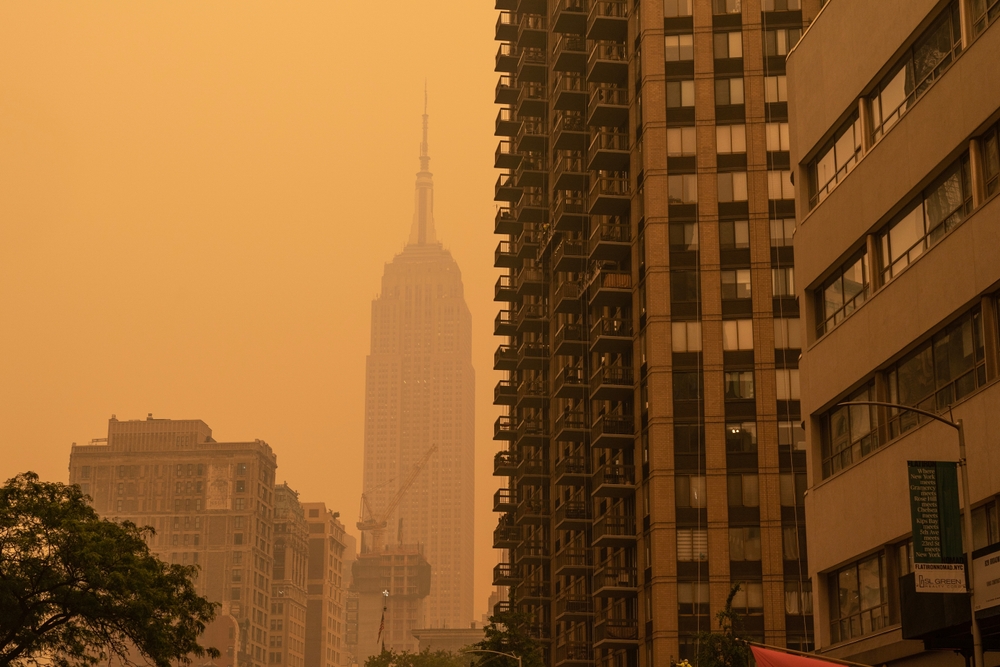Back to Basics is a weekly feature that highlights important but possibly overlooked information that any EHS professional should know. This week, we examine particulate matter pollution and the effects on human health and safety.
Due to the recent wildfires and smoke on the East Coast and Canada, OSHA has urged employers to protect their outdoor employees from the poor air quality. It is important that safety professionals understand particulate matter and wildfire smoke hazards, and how to keep workers safe when outdoor air quality decreases.
Particulate matter
According to the Environmental Protection Agency (EPA), particulate matter (PM), or particle pollution, is a mixture of solid particles and liquid droplets found in the air. The particles come in many shapes and sizes, and they can be made up of hundreds of different chemicals. Some particles like dust, dirt, soot, and smoke are large enough to be seen by the naked eye, while others are too small and can only be seen with an electron microscope.
PM can be emitted directly from a source, such as construction sites, unpaved roads, fields, smokestacks, or fires. Most particles form in the atmosphere as a result of complex reactions of chemicals such as sulfur dioxide and nitrogen oxides, which are pollutants that come from power plants, industries, and automobiles.
The EPA says that PM contains microscopic solids or liquid droplets that can be inhaled and cause serious health issues. Particles less than 10 micrometers are able to get into the lungs and the bloodstream. PM less than 2.5 micrometers in diameter poses the greatest threat to a person’s health. Particle pollution exposure can lead to:
- Premature death in people with heart or lung disease
- Nonfatal heart attacks
- Irregular heartbeat
- Aggravated asthma
- Decreased lung function
Exposure can also lead to increased respiratory symptoms, such as irritation of the airways, coughing, and difficulty breathing. Those with heart or lung diseases, children, and older adults are the most likely to be affected by exposure to particle pollution.
Fine particles are also the main cause of reduced visibility, or haze, in parts of the United States, including in national parks and wilderness areas. Particles can be carried over long distances by wind and then settle on the ground or in the water. The effects of this settling might include the following:
- Making lakes and streams acidic
- Changing the nutrient balance in coastal waters and large river basins
- Depleting the nutrients in soil
- Damaging sensitive forests and farm crops
- Affecting the diversity of ecosystems
- Contributing to acid rain effects
PM can also stain and damage stone and other materials, meaning that culturally important objects such as statues and monuments are also in danger from PM exposure.
Smoke exposure
According to the National Institute for Occupational Safety and Health (NIOSH), wildfire smoke is a complex mixture of gases and particles from burning vegetation and other materials. Different compounds are released in the smoke, including carbon monoxide and dioxide, hydrocarbons, benzene, acrolein, aldehydes, and particulate matter.
Though there is limited information about how wildfire smoke affects outdoor workers, NIOSH says that there is clear potential for exposures to result in adverse health outcomes. Some of the known and suspected health effects of wildfire smoke exposure include:
- Eye irritation, sore throat, wheeze, and cough
- Asthma and chronic obstructive pulmonary disease (COPD) exacerbations
- Bronchitis and pneumonia
- Adverse birth outcomes
- Cardiovascular outcomes
Workers may also experience varying health effects from smoke. Longer work schedules and physically demanding work that results in higher breathing rates may impact exposures and health responses. Employers are responsible for knowing that wildfire smoke may adversely affect their employees’ health, and they must prepare to take action to limit exposures when wildfires are producing smoke in and around the job site.
For employers
NIOSH recommends frequently monitoring air quality conditions in the area by using the EPA’s US Fire and Smoke Map and their state health department’s air quality website. Reschedule or relocate work tasks to smoke-free or less smoky areas or times of day. Reduce the levels of physical activity, when possible, especially strenuous and heavy work, and require and encourage workers to take frequent breaks in smoke-free areas.
Additionally, limit the worker’s smoke exposure by making accommodations for that worker to perform their duties indoors or in a location that reduces exposure when possible. An indoor environment that reduces exposure and protects occupants from wildfire smoke should have air cleaners with high-efficiency particulate air (HEPA) or electrostatic precipitators.
These areas should have all windows, loading docks, and bays kept closed to prevent smoke from coming inside, and the heating, ventilation, and air conditioning (HVAC) systems should be operating in the re-circulate setting. Employers should also install the highest efficiency filters recommended by the designer or manufacturer of the HVAC system.
While preventing exposures through elimination, substitution, and engineering and administrative controls is the most effective was to prevent smoke hazards, sometimes the use of personal protective equipment (PPE) such as respirators is necessary, NIOSH says. A NIOSH Approved® filtering facepiece respiratory (FFR) or an N95® respirator can be used to reduce exposure to airborne particulates from wildfire smoke. Any kind of PPE required by the employer must be compliant with OSHA’s respiratory protection standard.

